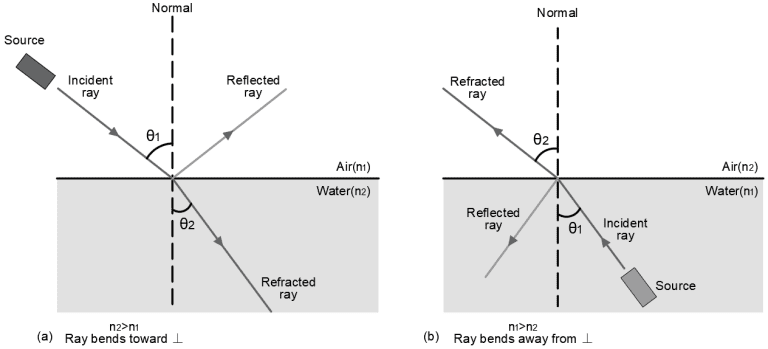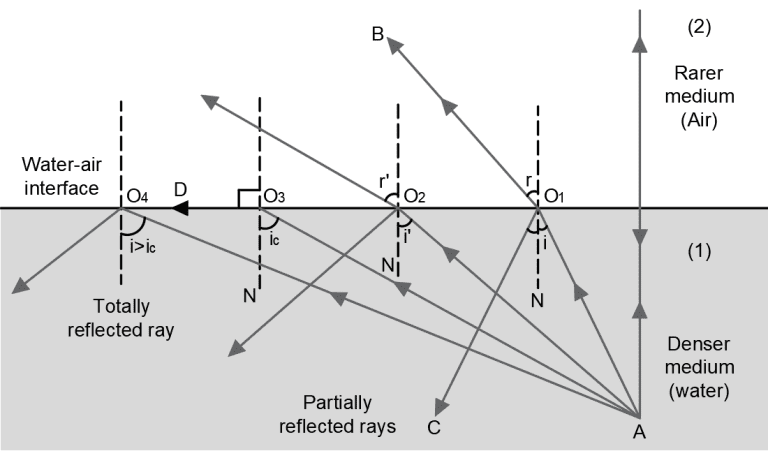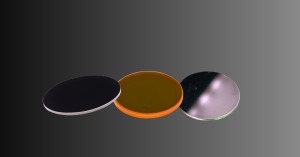Key Takeaways:
- The study of light and optics explores phenomena like Total Internal Reflection, where light reflects within a denser medium beyond a critical Angle of Refraction, crucial for optical understanding.
- Light, spanning 400nm to 700nm, enables human vision and plays a fundamental role in optical science.
- Laws such as Snell’s Law govern how light reflects and refracts at surfaces and through different mediums, essential in optics.
- Practical applications in science and technology utilize optical principles, influencing fields from instrument design to medical imaging advancements.
Exploring the Intricacies of Light and Optics
Light, an essential component of our visual perception, is the radiant energy that manifests within the visible light spectrum, spanning wavelengths from 400nm to 700nm. This range, perceptible by the human eye, enables us to visually comprehend the world around us. Operating at the astonishing speed of 3 X 10^8 m/s, light has intrigued scientists and physicists for centuries. As we delve into the intricacies of light, we encounter fundamental concepts such as rays, beams, optics, reflection, and refraction. Each facet unravels a layer of understanding in the complex interplay between light and matter, shaping the branch of physics known as optics. This exploration guides us through the laws governing reflection and refraction, introducing concepts like Snell’s Law and Total Internal Reflection, shedding light on the phenomena that occur when light transitions through different mediums. Join us on this journey into the world of light and optics, where the seemingly simple nature of illumination reveals profound and fascinating principles.
Light:
Light is the radiant energy that falls within the visible light spectrum, spanning wavelengths from 400nm to 700nm. This range is perceivable by the human eye, allowing us to visually comprehend our surroundings. The speed of light, the fastest achievable speed in the universe, is 3 X 10^8 m/s.
Ray of Light:
A ray is the trajectory traced by light when moving from one point to another.
Beam of Light:
A collection of light rays is referred to as a beam of light.
Optics:
Optics, a branch of physics, is concerned with investigating how light interacts with matter and understanding its behavior.
Reflection of Light:
When light traveling through air encounters a reflective surface, it undergoes reflection. The Angle of Incidence, formed between the incident light and the surface’s normal, equals the Angle of Reflection, which is the angle between the reflected light and the normal.
Laws of Reflection:
- The angle of incidence equals the angle of reflection.
- The incident ray, the normal, and the reflected ray lie in the same plane.

Refraction of Light:
Refraction occurs when a light ray, traveling through air, enters a different medium. The ray either bends toward or away from the normal, depending on the transition from a lighter to denser medium or vice versa.

Snell’s Law or Laws of Refraction:
- The incident ray, the refracted ray, and the normal lie in the same plane.
- The ratio of the sine of the angle of incidence to the angle of refraction is constant, represented by n2/n1, known as the refractive index.

Total Internal Reflection:
Total Internal Reflection (TIR) occurs when a ray of light transitions from a denser medium to a rarer medium. In this process, a fraction of the light reflects back into the denser medium, while the remainder enters the second medium and undergoes refraction. However, beyond a certain point, the incident ray experiences complete reflection and ceases to undergo further refraction. This phenomenon is recognized as Total Internal Reflection.
In situations where a ray of light moves from a denser medium, such as water, to a rarer medium, like air, a portion of the light (represented by ray AO1) is reflected back into the denser medium (O1C) at an angle known as the Angle of Incidence (i). Simultaneously, another portion of the light is refracted into the rarer medium, deviating at an angle from the normal, known as the Angle of Refraction (r).
Observing the associated diagram, it becomes evident that the angle of refraction increases as the angle of incidence is augmented. At a specific point (AO3), the angle of refraction reaches 90°, resulting in the incident ray (AO4) undergoing total reflection. Beyond this critical point, any further increase in the angle of incidence leads to total internal reflection, and there is no additional refraction.
The specific angle at which the angle of refraction becomes perpendicular to the normal, i.e., 90°, is termed the Critical Angle. At this critical angle, the reflection transforms into Total Internal Reflection, signifying the point beyond which no further refraction occurs.

Conclusion
In conclusion, the journey through the realms of light and optics has unveiled a captivating tapestry of scientific principles that govern the behavior of radiant energy. From the fundamental nature of light as a visible spectrum to the intricate trajectories traced by rays and beams, the exploration has illuminated the depth of our understanding. The laws of reflection and refraction, including Snell’s Law and the phenomenon of Total Internal Reflection, provide a comprehensive framework for comprehending how light and optics interact with matter. As we navigate through the angles and transitions, it becomes apparent that the study of light and optics not only enhances our scientific understanding but also has practical applications in various fields, from technology to medicine. This journey into the nuances of light leaves us with a profound appreciation for the elegance and complexity that underlie the seemingly simple phenomenon of illumination.
GREAT ARTICLE!
Share this article to gain insights from your connections!





